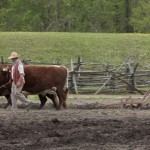The weather so far in 2015 has delivered one headache after another.
California is parched from years-long drought. In much of the South, the opposite is true, with some areas receiving five times their normal rainfall. And who can forget the scenes of New England’s record-breaking snowfall where some places saw totals of more than 100 inches?
It has likewise been an off year in Virginia’s Colonial capital, though much tamer in scale.
Still, said Historic Farming interpreter Wayne Randolph, the conditions affected the work at Great Hopes Plantation, Colonial Williamsburg’s re-created family farm. Extended periods of wet, cool weather disrupted the normal planting schedule.
“Everything went in late,” said Randolph. “Corn usually goes in sometime in early April. We planted it in late April and early May.”
Those few weeks of delay may seem like a big deal to many modern Americans accustomed to food, cash and climate-control on demand. But for their Colonial ancestors, whose livelihood grew just feet from their front door, a bout of bad weather meant much more than keeping the overcoat handy awhile longer. Families’ fortunes rose and fell with forces beyond their control. Two centuries later, guests to Colonial Williamsburg can get a sense of those difficulties at Great Hopes Plantation.
That surfeit of cold and wet weather this year has been worrisome for Historic Farming interpreters because a single issue: Late planting, often creates other problems that snowball and translate into crop failure. “When you put crops like tobacco in the ground late, it can cause the number of insects to increase,” said Randolph.
Sometimes the interpreters at Great Hopes Plantation have conversations with guests while plowing or harrowing, moving up and down long rows as they turn fresh earth. There’s a short window of time for specific tasks to get done and the farmers must take every opportunity to complete that work.
Disruptions to the planting schedule are only one of a host of recurring problems that plague this working farm. Weeds continually choke out crops. Deer, geese and groundhogs are among the critters that see these fields as effortless food. And that’s to say nothing of insects, fungi and diseases that can decimate plants while the folks who put copious amounts of labor into them look on, powerless to help.
All those troubles that visit Great Hopes Plantation, vexing as they may be, are a reflection of the frustrations of farmers-that is to say the vast majority of Americans-long ago.
“Am I always to be thus unlucky?” Landon Carter wrote in July 1757. Carter was a prominent Virginia planter and prolific diarist who wrote often about agriculture. “I can truely say that from 1749 to this year I have not had one tollerable seasonable year.”
Carter’s diary in places reads like a troubleshooting manual for the 18th-century yeoman:
On March 6, 1758: “Began this day to sow Oats. The weather till now has been so bad I could not put a seed in Sooner.”
On March 25, Carter reported seven cattle that had died from various causes, “In spite of all our care.”
On April 5, he once again vented his frustration with finicky weather: “This day a Frost and so has it been this 12 or 14 days…As a Farmer or Planter I must call it a bad Season.”
An insect pest-the tobacco fly-had infested his seed beds and laid waste to the young plants he was relying on to transplant to individual hills, about a foot high, where they would grow to size.
On April 27, Carter wrote he had “now scarcely a plant to be seen—such have the ravages of the Flye been.”
Carter calculated that on part of his land, his enslaved laborers had created 280,000 tobacco hills, one for each plant he wished to sow. But only 10,000 seedlings were available thanks to the tobacco fly. No matter, though, because the weather in 1758 was yet to reveal the depths of its madness.
By May 10, Carter had seen writing on the wall: “This is the third morning running I have to observe there was a white frost which added to the parching heat in the day and excessive dry weather must certainly destroy the Crops and fruit of every kind.”
Indeed, that year a drought decimated the tobacco crop. Some landed gentry like Carter were able to absorb those losses, though most middling farmers had no such financial cushion. Virginians in 1776 were indebted to British creditors by more than £1.3 million, over 46 percent of all Colonial debt to the mother country.
Agriculture has come a long a long way since the 18th century, effectively eliminating the grip that weather had on peoples’ day-to-day existence. That relationship was once more than just headlines. It was life.
Ed Schultz, Supervisor of Historic Farming, said that Great Hopes Plantation, and all the frustrations he encounters there, is a common history for every guest who stops by. “This was an agriculturally-based society in the 18th century. This was home. This was you. Even if you had ruffles on your shirt, looking out at someone else doing the work, this was your experience.”
 Ben Swenson lives in Williamsburg, Virginia with his wife and two sons. His writing career has led him to all sorts of odd corners of the world: he has jumped out of a perfectly good airplane, wrestled crab pots on a Chesapeake Bay work boat and taken a helicopter ride through a twisting river gorge. Odds are good you will find him outside with them somewhere when he is not chasing or telling stories.
Ben Swenson lives in Williamsburg, Virginia with his wife and two sons. His writing career has led him to all sorts of odd corners of the world: he has jumped out of a perfectly good airplane, wrestled crab pots on a Chesapeake Bay work boat and taken a helicopter ride through a twisting river gorge. Odds are good you will find him outside with them somewhere when he is not chasing or telling stories.


Wayne Randolph says
Excellent story. The precarious nature of our farming past was well articulated and thought provoking. Bravo!